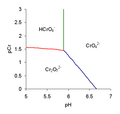Chromate and dichromate
Chromate and Dichromate are chemical compounds containing the chromate (CrO4^2-) and dichromate (Cr2O7^2-) ions, respectively. These compounds are oxoanions of chromium in the +6 oxidation state, also known as hexavalent chromium. Chromates and dichromates are highly corrosive and are used in a variety of industrial processes, including as pigments in paints, inks, and plastics, and in the tanning of leather. They are also important in the manufacture of chromic acid and in electroplating.
Chemistry[edit]
Chromate and dichromate ions are interconvertible in aqueous solution, depending on the pH. At high pH, the chromate ion (CrO4^2-) predominates, while at low pH, the dichromate ion (Cr2O7^2-) is more stable. This equilibrium can be represented by the following chemical equation:
CrO4^2- + 2H+ ↔ Cr2O7^2- + H2O
Chromates and dichromates are strong oxidizing agents and can react with a variety of organic and inorganic substances. They are also known to be carcinogenic and pose significant environmental and health risks if not handled properly.
Uses[edit]
Chromate and dichromate compounds have a wide range of applications. They are used in the production of chromium-based pigments, which are used to impart yellow, orange, and red colors to paints, inks, and plastics. These compounds are also used in the tanning of leather, as oxidizing agents in organic synthesis, and in the manufacture of chromic acid, which is used in chrome plating and as a corrosion inhibitor.
Health and Environmental Concerns[edit]
Hexavalent chromium compounds, including chromates and dichromates, are highly toxic and carcinogenic. Exposure to these compounds can lead to severe respiratory problems, skin ulcers, and lung cancer. Due to their high toxicity, the use and disposal of chromate and dichromate compounds are strictly regulated in many countries.
Environmental exposure to chromates and dichromates can occur through the improper disposal of industrial waste, leading to contamination of water and soil. These compounds are highly soluble in water, making them a significant environmental pollutant that can affect aquatic life and enter the food chain.
Regulation and Safety[edit]
Due to the health and environmental risks associated with chromate and dichromate compounds, their use is regulated by various international and national agencies. Workers handling these compounds are required to use appropriate personal protective equipment (PPE), and industries using these chemicals must adhere to strict waste management and disposal protocols to minimize environmental contamination.
Conclusion[edit]
Chromate and dichromate compounds play a significant role in various industrial applications but pose serious health and environmental risks. Proper handling, use, and disposal of these compounds are essential to minimize their adverse effects.
-
Chromate and dichromate predominance diagram
-
Chromate and dichromate
-
Crocoite from Tasmania
Ad. Transform your life with W8MD's Budget GLP-1 injections from $75


W8MD offers a medical weight loss program to lose weight in Philadelphia. Our physician-supervised medical weight loss provides:
- Weight loss injections in NYC (generic and brand names):
- Zepbound / Mounjaro, Wegovy / Ozempic, Saxenda
- Most insurances accepted or discounted self-pay rates. We will obtain insurance prior authorizations if needed.
- Generic GLP1 weight loss injections from $75 for the starting dose.
- Also offer prescription weight loss medications including Phentermine, Qsymia, Diethylpropion, Contrave etc.
NYC weight loss doctor appointmentsNYC weight loss doctor appointments
Start your NYC weight loss journey today at our NYC medical weight loss and Philadelphia medical weight loss clinics.
- Call 718-946-5500 to lose weight in NYC or for medical weight loss in Philadelphia 215-676-2334.
- Tags:NYC medical weight loss, Philadelphia lose weight Zepbound NYC, Budget GLP1 weight loss injections, Wegovy Philadelphia, Wegovy NYC, Philadelphia medical weight loss, Brookly weight loss and Wegovy NYC
|
WikiMD's Wellness Encyclopedia |
| Let Food Be Thy Medicine Medicine Thy Food - Hippocrates |
Medical Disclaimer: WikiMD is not a substitute for professional medical advice. The information on WikiMD is provided as an information resource only, may be incorrect, outdated or misleading, and is not to be used or relied on for any diagnostic or treatment purposes. Please consult your health care provider before making any healthcare decisions or for guidance about a specific medical condition. WikiMD expressly disclaims responsibility, and shall have no liability, for any damages, loss, injury, or liability whatsoever suffered as a result of your reliance on the information contained in this site. By visiting this site you agree to the foregoing terms and conditions, which may from time to time be changed or supplemented by WikiMD. If you do not agree to the foregoing terms and conditions, you should not enter or use this site. See full disclaimer.
Credits:Most images are courtesy of Wikimedia commons, and templates, categories Wikipedia, licensed under CC BY SA or similar.
Translate this page: - East Asian
中文,
日本,
한국어,
South Asian
हिन्दी,
தமிழ்,
తెలుగు,
Urdu,
ಕನ್ನಡ,
Southeast Asian
Indonesian,
Vietnamese,
Thai,
မြန်မာဘာသာ,
বাংলা
European
español,
Deutsch,
français,
Greek,
português do Brasil,
polski,
română,
русский,
Nederlands,
norsk,
svenska,
suomi,
Italian
Middle Eastern & African
عربى,
Turkish,
Persian,
Hebrew,
Afrikaans,
isiZulu,
Kiswahili,
Other
Bulgarian,
Hungarian,
Czech,
Swedish,
മലയാളം,
मराठी,
ਪੰਜਾਬੀ,
ગુજરાતી,
Portuguese,
Ukrainian



